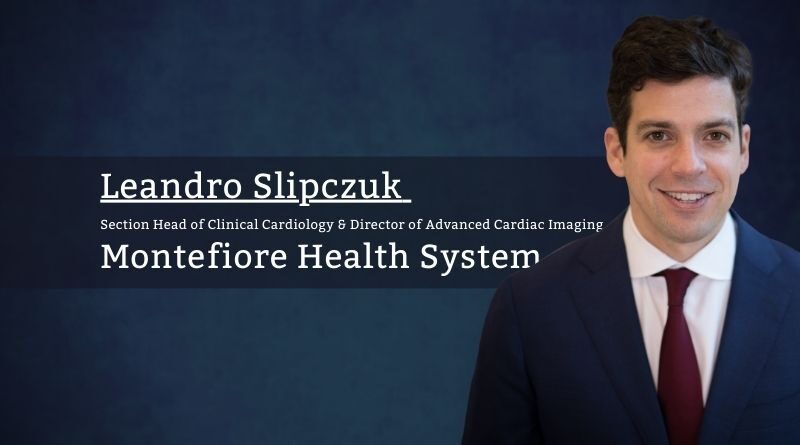Cardiac CT is reshaping the way we identify and treat coronary atherosclerosis
By Leandro Slipczuk MD, PhD, FACC, Section Head of Clinical Cardiology and Director of Advanced Cardiac Imaging, Montefiore health system
Atherosclerotic cardiovascular disease (ASCVD) is an ongoing epidemic, and atherogenic lipoproteins are one of its root causes. Mostly, first cardiac events occur in asymptomatic individuals, and therefore waiting for symptoms to develop is not a feasible strategy. Risk scores have been developed from the Framingham risk score to the pooled cohort equation (PCE) to estimate the likelihood of a person developing ASCVD over a defined period. However, they have shown significant limitations, including over or underperforming in ethnic minorities, the lack of acknowledgment of dynamic changes in risk factors, and the over-reliance on age. Identification of obstructive coronary artery disease (CAD) has traditionally constituted the center for risk stratification in patients with chest pain and functional stress testing still represents the preponderant modality for chest pain evaluation. The burden of non-obstructive plaque has recently grown to play a major role in predicting cardiovascular events (MACE). Even though functional capacity has clear prognostic implications, on its own, it does not include the evaluation of non-obstructive CAD. The development of coronary artery calcium scoring (CAC) and later CT coronary angiography (CCTA) surged as potential complementary tools to visualize coronary plaque and provide the basis for individualized management directly. It is now accepted that CAC can reclassify asymptomatic individuals, in particular, in the borderline to intermediate risk and personalize therapy to those who will benefit the most from preventative therapies or those who will receive less benefit (termed ‘power of zero’). In recent large randomized clinical trials, such as the PROMISE and SCOT-HEART, the use of CCTA in symptomatic patients was associated with a lower risk for myocardial infarction than conventional management, mostly due to the intensification of preventive therapies. Importantly, in the SCOT-HEART trial, these findings were also present in patients with non-cardiac chest pain, raising the possibility of its value in plaque detection to guide preventative therapies initiation in asymptomatic individuals. Given low radiation with newer scanners (down to 1 mSv with some scanners and safety protocols), the possibility of performing CCTA over CAC has gained momentum in patients in whom CCTA has been previously not commonly used. These include selected asymptomatic high-risk or younger individuals, especially those with a higher likelihood of having a large amount of non-calcified plaque. The presence of predominantly non-calcified plaque is more prevalent in young (age< 45–50 years) and female individuals.
Moreover, the burden of CAC and the relationship to non-calcified plaque may differ between ethnicities. Other groups of patients who have risk factors such as diabetes, HIV, smoking, inflammatory conditions (e.g., systemic lupus erythematosus, rheumatoid arthritis, or psoriasis), familial hypercholesterolemia, or those working in high-hazard occupations or a strong family history of premature ASCVD, may also present underlying CAD without CAC and may benefit from CCTA screening instead of CAC. Beyond stenosis and clinical variables, recent data suggests that the overall amount of coronary plaque by CCTA is a lead predictor of incident coronary events. Indeed, the ability to detect calcified and non-calcified plaque is a unique attribute of CCTA.
Newer artificial intelligence-driven software platforms complement CCT allowing further quantification of the particular CAD phenotype.
Subclinical CAD is not uncommon. The SCAPIS trial in Europe, conducted in middle-aged individuals without known CAD (50.6% women), demonstrated any CCTA-detected atherosclerosis in 42% and any significant stenosis (≥50%) in 5%. Similarly, the MiHeart study in Florida, included asymptomatic individuals with independent predictors of plaque: older age, male sex, tobacco use, diabetes, overweight, and obesity. Overall, 49% of participants had coronary plaque. It is thus suggested that CCTA can potentially be a game changer through identification of subclinical CAD.
In addition, cardiac CT (CCT) can evaluate epicardial adipose tissue (EAT) and pericoronary adipose tissue (PCAT), inflammation imaging markers that have proven to be associated with coronary atherosclerosis and MACE. Higher visualization of these features with CCTA has the potential of medical therapy tailoring to the patient’s risk phenotype. In addition to stenosis, CCTA can provide qualitative analysis typically focusing on detecting stenosis and estimating overall plaque volume and composition. More recently, this has included identifying specific plaque findings associated with high-risk plaques (HRP). These characteristics include four specific imaging findings, namely the presence of low-attenuation plaque (LAP), outward or positive remodeling of the coronary wall, small “spotty” plaque calcifications, and the napkin-ring sign. Currently, the presence of two or more of these features is required to define a HRP.
Newer artificial intelligence-driven software platforms complement CCT allowing further quantification of the particular CAD phenotype. In a further analysis of patients undergoing CCTA in the SCOT-HEART trial, elevated PCAT (more inflamed) added to high LAP burden, provided an improved prediction of future myocardial infarction. It still remains unknown if these particular features can predict events in asymptomatic individuals and whether they can be used to select the intensity of preventative treatments such as lipid lowering therapies.
Despite the presence of high-risk features on imaging, very few “vulnerable” plaques go on to cause MACE. Whilst the specific plaque identified at the time of imaging may itself be unlikely to cause an MI, the patient remains at increased risk from one of the many other or future adverse plaques that will develop over time. The concept of integrating the overall risk profile and evaluating the entire coronary tree might further improve risk prediction, with the notion that multiple plaques with multiple adverse plaque features carry a larger risk than the identification of an individual HRP. The combination of HRP, stenosis severity, and burden (including high-risk plaque burden) can maximize the prognostic information from CCTA and are changing the way we identify and treat coronary atherosclerosis.



